What to know
Vaginal and vulvar cancers are very rare. While all women are at risk for these cancers, very few will get them.

US Cancer Statistics Data Visualizations Tool
The Data Visualizations tool makes it easy for anyone to explore and use the latest official federal government cancer data from United States Cancer Statistics. It includes the latest cancer data covering the US population. See information about vaginal cancer and vulvar cancer.
